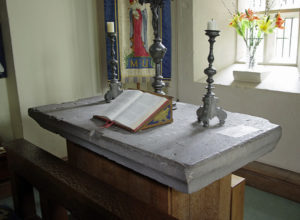Conisbrough was a royal burgh in Saxon times and St Peter’s Church is probably the oldest building in South Yorkshire. Christianity came early to this area and there is the remains of a preaching cross in the churchyard which probably predates the church.
The church is set on the highest part of the town and is C8th or even older. It was a Minster church for the surrounding area. It still retains its Saxon core with a long, tall and narrow nave and west tower.
The oldest parts of the church date from 1050 with the nave and base of the tower. By the C12th, Conisbrough was a thriving settlement and a new stone “castle”:http://wasleys.org.uk/eleanor/castles/england/yorkshire/conisborough/index.html was being built. The side aisles were added to hold the increasing number of worshippers. There was further work in the C15th when the chancel was extended, clerestory added and the tower heightened. The lancet windows in the side aisles were replaced by larger square windows. The south porch was built and crenallated parapets and pinnacles added to everything. The church assumed the Perpendicular style still seen today.
There was a major restoration in the C19th. Walls were stripped down to the bare stonework and wall paintings were lost. The north aisle was rebuilt and extended and a organ chamber added. The vestry was removed. A new tall arch gave entry into the base of the tower and a stone rood screen base built across the chancel. The stone pulpit is C19th. The wooden pews are C20th and the work of Robert Thompson of Kilburn. His signature mouse can be found throughout the church.
Built into the wall of the south porch is a piece of Romano-British carving. The jury is out as to whether this is the Virgin and Child or St Peter with the key of Heaven. Below it is a carved slab of unknown date.
The Norman door arch with its chevron carving still survives, although the side pillars with their carved capitals are Victorian.
Part of the 1050 nave survives in the stonework above the arcades and a blocked Saxon window can still be seen. The north arcade with its round pillars and round arches was built first. The south arcade with its pointed arches is slightly later.
The pillars have carved capitals, all different. The one at the back of the north arcade is unusual and is thought to be a bit of recycled Roman masonry from a nearby villa, with the figures of Roman soldiers. Their heads were knocked off by Puritan iconoclasts.
At the back of the north aisle are two Norman windows, a survival of the C19th restorations. They contain Medieval stained glass with the figures of Old Testament characters.
The tall pointed arch into the base of the tower is C19th but the low round arches of the 1050 church survive inside the bottom of the tower. This area is now the baptistry with a carved stone font dating from about 1400. As well as the usual shields this also has a carved figure of the Risen Christ stepping out of the tomb and another of the sitting Christ in Majesty.
The C12th chancel arch survives although the carving under it is probably either C14th or C15th. The stone screen at the base of the arch is C19th and has the symbols of the four evangelists carved on it. By it is the C19th stone pulpit
On the north wall of the chancel is the blocked doorway that led into the now demolished Priest’s vestry. This looks very low as over the years the level of the church floor has risen as bodies were buried under the church. On the far side of it is a square lychnoscope (squint) which allowed the priest to look into the chancel.
The glass in the east window is mid C19th and has scenes from the life of Jesus, beginning with his Baptism, Crucifixion, Resurrection and finally his Ascension into Heaven.
One of the windows in the south wall has fragments of Medieval glass. These include part of the Virgin Mary on the left. On the right is part of a Bishop, possibly Prior Atwell from Lewis Priory, which the church was attached in the C13th. Next to it, and very different is a late C20th stained glass window.
The chapel at the end of the north aisle is dedicated as the War Memorial chapel to the dead of the Second World War. It has a squint into the chancel. On top of the altar is the stone Mensa slab from the chapel of Conisbrough Castle, with its five small consecration crosses and small niche to hold a relic box.
There used to be a chantry chapel at the end of the south aisle and the piscina and ambry cupboard survive. On the wall is a modern sculpture of Christ holding out his hand for Christians to come and follow him.
On the floor is an old tomb slab with the remains of two ravens carved on the top. The date is unknown. It could be Saxon as ravens were a common symbol in Saxon heraldry. Alternatively it could be of a member of the de Warren family, keepers of the castle in the C13th and C14th, who had two ravens on their family crest.
Near it is an elaborately carved tomb chest dated from around 1150-60. On the lid are mounted knights, winged beasts and signs of the zodiac. On the base is St George fighting an impressive dragon with a bishop holding a crozier looking on. Although it looks older, the legend of St George didn’t arrive in this country until 1150 when it was brought back from Turkey by Crusader knights.
This is a wonderful church, still retaining the feel of a Saxon/Norman church. It is open daily 9-5. There is plenty of parking nearby. The post code is DN12 3HL and the grid reference is SK 512988.
There are lots more pictures “here.”:http://wasleys.org.uk/eleanor/churches/england/yorkshire/south_yorkshire/conisbrough/index.html










